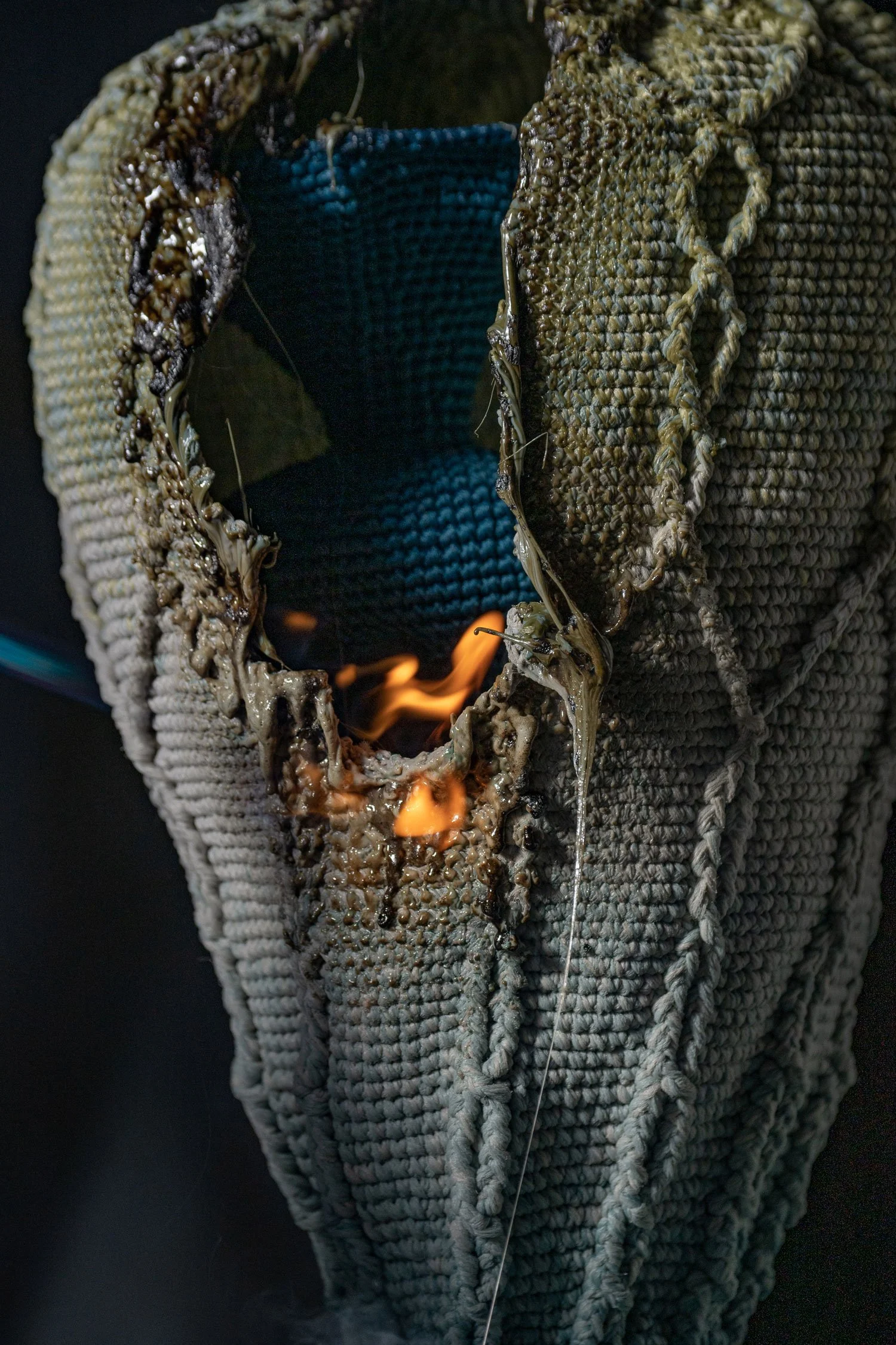This is a written version of the speech that I wrote and delivered for the TEDxCMU (Carnegie Mellon University, PA) in 2022. You may view the recording of the virtual livestream here.
Why bother spending so much time making something you could easily get at a lower price? In this fast-paced world, where does a slow craft like crochet have a place?
I come from a tiny but high-stress city known as Singapore. In a country that places so much emphasis on speed and efficiency, crafts are often seen as a ‘waste of time’. However, as someone who has lived with crochet for the past 24 years, I find it is the one thing in my life keeping me balanced as life speeds past, through its repetitive motions that are strangely therapeutic.
It seems many others have discovered this for themselves ever since the pandemic hit the world. One of my students likens counting crochet stitches to counting prayer beads, and I find it an apt symbol of the meditative effect crochet has, especially during times of uncertainty. This might be the reason slow craft, from pottery to baking, was what people turned to as the pandemic raged on. Cut off from physical social interactions and jaded from overindulging in our digital devices– we found what our hands could do for us from the simplest of materials, tools and our greatest resource: Time. We found the joy of creation, often mistaken as the troublesome way of feeding and clothing ourselves as we favour convenience in current times. And in re-learning how to take care of ourselves, we enjoyed the fruits of our labour; the irreplaceable satisfaction of being self-sufficient.
However, the current trend in media seems to preach the opposite: Publish, or perish. As the pandemic passed its peak of danger, these slow crafts that people adopted to cope with the sudden change in the pace of life turned into yet another chunk of ‘content’.
Ironically, these slow crafts like crochet are presented in videos that are deliberately sped up or edited to make them look simple. Everyone seems to be in a race to dish out bite-sized content overwhelming our senses. There is even a rise of ‘tik tok art’, where making ‘art’ quickly is celebrated. Why has being able to be fast turned into a badge of honour?
As the world conditions us to focus on the end product, many are forgetting that the point of craft is the process. Crafts have turned into money-making skills, hobbies that can now churn out rewards (sometimes in the form of social media currency). Unfortunately, the joy of creation is often lost once we consider it in terms of transaction, because the focus shifts to the destination– the completion of the piece. Where completion once brought satisfaction of having a certain capability, it is now traded for the satisfaction of obtaining the REWARD. Instead of the therapeutic joy of creation, we end up ‘punishing’ ourselves by working as quickly as we can to obtain MORE Rewards, essentially turning ourselves into a mini factory.
That is how ‘slow craft’ could be a wolf in sheep’s clothing.
How then, do we disconnect from the ‘Destination’ and focus on the Journey?
A friend once asked how I would describe Crochet as a lover. As she works with paper, she described Paper as an unforgiving lover, remembering every crease and stain. That’s when I realised Crochet is the best lover you might have. It always forgives, as long as you are willing to go back and undo the knots. You could crochet or knit a sweater, then undo and remake a different one years later, recognising that destinations are not final and will change along with us as we grow. Crochet is a path we walk between our house and a certain place to and fro, again and again, until we can walk it with our eyes closed. It is the special ability of crochet to forgive that makes you fall in love with that same walk that shows you new things each time.
That process of making, and then unraveling and remaking is both heart-breaking and therapeutic. It becomes a choice of focusing on ‘all that time wasted’, or on the liberation of always being able to re-invent oneself while enjoying the process. It teaches you not to be precious about things, and about the impermanence of life. Once you disconnect from the goal of completion, crochet gives you enjoyment in every moment, with each stitch representing a moment passing in time.
Unraveling your stitches does not mean total erasure. While each stitch represents a moment in time, undoing them doesn’t mean you ‘went back in time’, does it? They might have vanished from view, but what was made and undone had taught you new lessons.
Committed, 2022
Crocheted and melted nylon yarn
My recent explorations aim to bring attention to the present moment of making by deliberately melting and burning lace doilies and crocheted Vases that take weeks to complete. People often go, “what a waste!” when I tell them about my process, but it is actually quite liberating to know that the thing you are creating is going to be destroyed the moment you begin on it. It allows you to feel the joy in the present moment of making, much like the sand mandalas created by Tibetan monks, which are destroyed once they are complete.
In that same line of thought, there is actually more to art than simply the ‘destination’, which is the final artwork you see. I like to think of the Artwork as a beginning more than an end, as it potentially plants a new seed of thought into someone’s head from the moment they look at it.
In that way, the artwork becomes a ‘medium’ for which a bigger message or cause is being carried. It can also be a means to empower people in its creation or alter ways of living, such as how craft can slow down the rhythm of life.
While volunteering for the Setouchi Art Triennale, an art festival in Japan, I observed how they revitalized depopulated islands by attracting the young population with artworks that complemented the natural beauty of the environment. The elderly folk on the island who were often left alone in their homes as their children moved to the cities for work, found a renewed sense of purpose in life by participating in the festival, some even taking it upon themselves to show tourists around. They also regained a sense of pride in the island on which they lived. Younger tourists visiting the islands recalibrated their pace in life by refreshing their minds with art and nature away from the busy cities.
People in the city often lament how lonely we feel even when we are surrounded by people, and how bored we are even when games, videos or tonnes of friends are available at a tap on your phone. It seems to be the effect of being overstimulated, trying to force as many activities as we can into a short period of time. Even art has become a thing to be consumed quickly.
However, in the art festival on the islands, the journey to discover the artworks is deliberately made inefficient, a protest against mindless consumption. Artworks are spread out across the island, accessible by foot or bicycle. The journey between each artwork is time to slow down for a breath, refresh your eyes, and enjoy nature.
In that way, the artworks are not the destination; they are a means of changing communities, and also part of the journey in making us city dwellers slow down and look differently at what is around us. In having to search for the artworks instead of having them dropped in our laps, or in some cases as we are all familiar with, pushed under our noses through the Instagram feed, the message becomes more precious. As we take on an active role in our lives to search for something, our sense of purpose is determined. Finding our own answers gives us an independence that empowers us, something we also experience as we work with our hands in practicing slow craft.
Crafting often requires each person to journey on their own creative solution, which contributes to that satisfaction of completion. I often work with local volunteers for my larger installation works, of whom many are housewives. They sometimes share how they experience a loss of their sense of purpose once their children have grown up and their husbands are busy with work. Craft is often their way of ‘passing time’, but it does more than just that. By making the conscious choice of challenging themselves, they are empowered by the pride of ‘solving’ a creative problem all on their own. Even if they had to trade days or weeks, the validation of being capable of being more than just a caregiver is worth it.
In my projects, the volunteers often had no idea how the artwork would turn out in the end, but simply wanted to be part of a bigger cause. Upon seeing the final installation, they would excitedly try to identify which parts they had made, awestruck at how their small effort could contribute to a bigger vision. In this way, Art acted as a medium to renew their sense of purpose. The reward for crafting in this case is not ‘transactional’, as they do not get anything tangible back in return for their participation; but the validation they feel from knowing they can make a change is irreplaceable.
I haven’t always been appreciative of this slow craft, and I’ve had (and still have) many moments of irritation and impatience trying to figure out this slow dance with crochet and all its knots. It is not something you can master at the flick of a switch, and something I’m still constantly learning from everyday. But that’s exactly what makes this journey so personal and precious.
It feels magical to me how working on a slow craft can make time seem to pass so fast, and I’m sure those who have experienced slow craft can agree.
Time flies when we live each moment with a purpose. In simply making conscious choices rather than passively consume in small acts of the everyday, we are taking baby steps to regaining a personal power to steer this roller coaster we call life.

